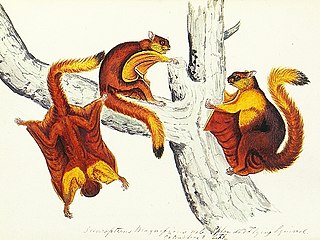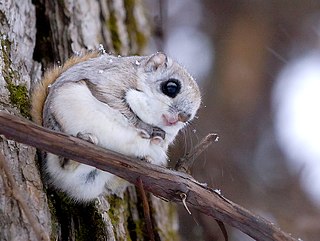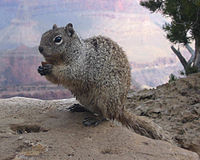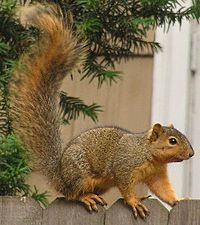
Flying squirrels are a tribe of 50 species of squirrels in the family Sciuridae. Despite their name, they are not in fact capable of full flight in the same way as birds or bats, but they are able to glide from one tree to another with the aid of a patagium, a furred skin membrane that stretches from wrist to ankle. Their long tails also provide stability as they glide. Anatomically they are very similar to other squirrels with a number of adaptations to suit their lifestyle; their limb bones are longer and their hand bones, foot bones, and distal vertebrae are shorter. Flying squirrels are able to steer and exert control over their glide path with their limbs and tail.

The western woolly flying squirrel is a species of very large flying squirrel in the genus Eupetaurus. It is native to northern Pakistan and northwestern India. It was long considered the only species in the genus until the description of two other species in 2021. Until recently, scientific knowledge of this rare species was limited to 11 skins collected in the late nineteenth century. However, recent research has confirmed that it remains in Kashmir. It is among the longest members of the family Sciuridae, and one of the biggest gliding animals known. Observations confirm that despite its size, it does glide effectively, like other flying squirrels.

The northern flying squirrel is one of three species of the genus Glaucomys, the only flying squirrels found in North America. They are found in coniferous and mixed coniferous forests across much of Canada, from Alaska to Nova Scotia, and south to the mountains of North Carolina and west to Utah in the United States. They are light brown with pale underparts and grow to a length of 25 to 37 cm. They are proficient gliders but uncoordinated walkers on the ground. They feed on a variety of plant material as well as tree sap, fungi, insects, carrion, bird eggs and nestlings. They mostly breed once a year in a cavity lined with lichen or other soft material. Except when they have young, they change nests frequently, and in winter a number of individuals may huddle together in a shared nest. Unlike most members of their family, flying squirrels are strictly nocturnal.

Sciurinae is a subfamily of squirrels, uniting the flying squirrels with certain related tree squirrels. Older sources place the flying squirrels in a separate subfamily (Pteromyinae) and unite all remaining sciurids into the subfamily Sciurinae, but this has been strongly refuted by genetic studies.

The squirrel glider is a nocturnal gliding possum. The squirrel glider is one of the wrist-winged gliders of the genus Petaurus.

The genus Petaurus contains flying phalangers or wrist-winged gliders, a group of arboreal possums native to Australia, New Guinea, and surrounding islands. There are eight species: the sugar glider, savanna glider, Krefft's glider, squirrel glider, mahogany glider, northern glider, yellow-bellied glider and Biak glider.

The three species of New World flying squirrels, genus Glaucomys, are the only species of flying squirrel found in North America. They are distributed from Alaska to Honduras. They are similar in many ways to the Eurasian flying squirrels in the genus Pteromys. Two species of New World flying squirrels can be easily distinguished on the basis of size and ventral pelage. Northern flying squirrels, Glaucomys sabrinus are larger and have belly hair that is dark at the base and white at the tip. Southern flying squirrels, Glaucomys volans, are smaller and have belly hairs that are completely white. Humboldt's flying squirrel is more difficult to distinguish from the northern flying squirrel where their ranges overlap. In fact, they were once considered conspecific. Humboldt's flying squirrel is considered a cryptic species. They are generally smaller and darker than northern flying squirrels.

The Japanese giant flying squirrel is a species of flying squirrel, one of the giant flying squirrels in the genus Petaurista.

The Siberian flying squirrel is an Old World flying squirrel ranging from the Baltic Sea in the west, throughout Northern Asia to the coast of the Pacific Ocean in the east. It is the only species of flying squirrel in Europe and is considered vulnerable in the European Union where it occurs only in Estonia and Finland. In Latvia, it was last sighted in 2001 and has been considered to be locally extinct since 2013.

A number of animals are capable of aerial locomotion, either by powered flight or by gliding. This trait has appeared by evolution many times, without any single common ancestor. Flight has evolved at least four times in separate animals: insects, pterosaurs, birds, and bats. Gliding has evolved on many more occasions. Usually the development is to aid canopy animals in getting from tree to tree, although there are other possibilities. Gliding, in particular, has evolved among rainforest animals, especially in the rainforests in Asia where the trees are tall and widely spaced. Several species of aquatic animals, and a few amphibians and reptiles have also evolved this gliding flight ability, typically as a means of evading predators.

The red giant flying squirrel or common giant flying squirrel is a species of rodent in the family Sciuridae (squirrels). It is found in a wide variety of forest–types, plantations and more open habitats with scattered trees in Southeast Asia, ranging north to the Himalayas and southern and central China. One of the largest arboreal squirrels, all populations have at least some reddish-brown above and pale underparts, but otherwise there are significant geographic variations in the colours. The taxonomic position of those in the Sundaic region is generally agreed upon, but there is considerable uncertainty about the others, which variously have been included in this or other species, or recognized as their own species.

Pel's flying squirrel or Pel's scaly-tailed squirrel is a species of rodent in the family Anomaluridae. It is found in Liberia, Ivory Coast, and Ghana, where it lives in lowland tropical rainforests. It is named after Hendrik Pel.

The dwarf scaly-tailed squirrel is a species of rodent in the family Anomaluridae. It is found in Cameroon, Central African Republic, Republic of the Congo, Democratic Republic of the Congo, Equatorial Guinea, Gabon and Uganda. The species is nocturnal and arboreal and lives in subtropical or tropical lowland rainforest. Membranes attached to its limbs and tail enable it to glide between trees. This squirrel is currently not considered to be threatened by habitat destruction; "much of the habitat within parts of the known range of this species is relatively intact, and the species is unlikely to be experiencing any significant declines."

The red and white giant flying squirrel is a species of rodent in the family Sciuridae. It is a very large, dark rufous-red, buff and white flying squirrel found in forests at altitudes of 800–3,500 m (2,600–11,500 ft) in mainland China and 1,200–3,750 m (3,940–12,300 ft) in Taiwan, although the population of the latter island is distinctive and likely better regarded as a separate species, the Taiwan giant flying squirrel. Additionally, the red and white giant flying squirrel possibly ranges into northeastern South Asia and far northern Mainland Southeast Asia. This squirrel has a wide range and is relatively common, and the International Union for Conservation of Nature lists it as being of "least concern".

Petaurista is a genus of rodent in the family Sciuridae. They are large to very large flying squirrels found in forests and other wooded habitats in southern and eastern Asia.

Hodgson's giant flying squirrel is a species of rodent in the family Sciuridae. This large flying squirrel lives in Himalayan forests in Asia. Like other flying squirrels, it is nocturnal and able to glide long distances between trees by spreading out its patagium, skin between its limbs.

The Japanese dwarf flying squirrel is one of two species of Old World flying squirrels in the genus Pteromys. During the day, this squirrel hides in a hole, usually in a coniferous tree, emerging at night to feed.

Humboldt's flying squirrel is one of three species of the genus Glaucomys, the only flying squirrels found in North America. The squirrel was named after the naturalist Alexander von Humboldt and California's Humboldt County, which is one of the areas inhabited by the squirrel.

The Ezo flying squirrel or Ezo-momonga is a subspecies of the Siberian flying squirrel. It is endemic to Hokkaidō, Japan, part of the region once known as Ezo. In the legends of the local Ainu, the Ezo flying squirrel or A-kamui is a tutelary deity of children. Together with the Ezo chipmunk and Ezo squirrel, it is one of the three sciurids found on the island, to the north of Blakiston's Line, each having its own particular ecological niche.





















